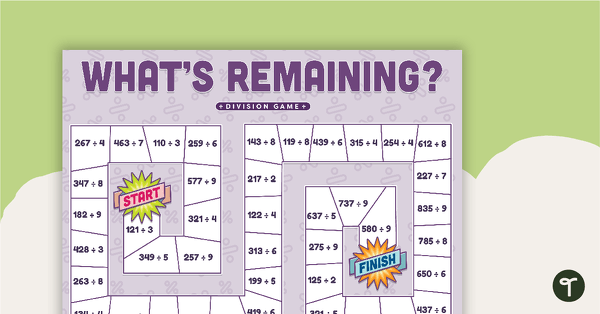Hey
there, fellow educators and game enthusiasts! Today, we're diving into the
exciting world of math, where numbers become our allies, not adversaries.
Imagine a classroom where the complexities of long division are not met with
sighs but with cheers of anticipation. Intrigued? Well, let's unpack the secret
sauce – "What’s Remaining? – Long Division Board Game."
Setting the Stage: Long
Division Unveiled
Long
division, the nemesis of many students, has a reputation for inducing groans
and furrowed brows. But what if we told you that the journey through long
division could be as thrilling as a suspenseful novel or an edge-of-your-seat
movie? Enter the stage: the Long Division Board Game.
The Game Unveiled: What’s
Remaining?
So,
what’s the buzz about "What’s Remaining?" Picture this: a vibrant
game board, eager students, and the mathematical battlefield of long division.
The goal is not just to find the quotient but to unravel the mystery of what
remains. It's like solving a math puzzle, but with the added twist of strategy
and competition.
How to Play: A Symphony of
Numbers
Now,
let's talk rules. The game board is your canvas, and each player is a
mathematical artist. The dividend, divisor, quotient – they all play a role in
this numerical symphony. Players take turns navigating the board, making
strategic moves, and tackling long division problems.
Roll
the dice, move your game piece, and face a long division challenge. Solve it,
and you advance. But wait, there's more! The real kicker is uncovering what
remains – the remainder. It's not just about getting the answer; it's about
mastering the entire process.
Why It Works: The Pedagogy
Behind the Fun
Now,
you might wonder, "Sure, it sounds fun, but does it really teach
anything?" Absolutely. "What’s Remaining?" isn’t just a game;
it's a covert educational mission.
1. Making Math Memorable
Let's
face it; long division can be a bit dry. But wrap it up in a game, and
suddenly, it's a memorable experience. The game creates a positive association
with long division, turning it from a chore into a challenge to conquer.
2. Active Engagement
Traditional
methods often have students as passive recipients of information. This game
flips the script. It makes learners active participants, turning long division
into a dynamic and engaging activity. No more sleepy eyes and disinterested
stares – it's all hands on deck!
3. Strategy and Critical Thinking
Long
division isn’t just about punching numbers into a calculator; it’s a strategic
process. "What’s Remaining?" amplifies this by introducing a layer of
strategy and critical thinking. Players need to plan their moves wisely,
fostering skills beyond basic arithmetic.
4. Healthy Competition
Competition,
when done right, is a powerful motivator. "What’s Remaining?"
introduces a healthy dose of competition into the learning environment. It's
not about outsmarting classmates; it's about outsmarting long division
problems.
5. Reinforcing Mathematical Concepts
The
game doesn't just stop at long division. It reinforces broader mathematical
concepts like division as a whole, understanding remainders, and applying
problem-solving skills. It’s like a math lesson in disguise.
Real Talk: The Teacher's
Perspective
Now,
let’s chat about how this game fits into the real world of teaching. As
educators, we're always on the lookout for tools that not only teach but also
resonate with our students. "What’s Remaining?" isn’t just a tool;
it’s a game-changer (pun intended).
1. Breaking the Monotony
Teaching
the same concepts repeatedly can lead to monotony, both for us and our
students. "What’s Remaining?" injects a dose of excitement into long
division lessons. It's a refreshing break from the routine.
2. Addressing Different Learning Styles
We
know our classrooms are diverse, with students having various learning styles.
Some are visual learners, some are tactile learners. This game caters to both,
offering a multi-sensory experience that accommodates different learning
preferences.
3. Fostering a Positive Learning Environment
Ever
notice how the atmosphere changes when students are genuinely excited about a
lesson? "What’s Remaining?" creates a positive learning environment.
Students aren’t just learning because they have to; they’re learning because
they want to win the game.
4. Seamless Integration into Lesson Plans
Worried
about fitting this into an already-packed curriculum? Fear not. This game
seamlessly integrates into lesson plans. It’s not an extra; it’s an
enhancement. Consider it the sprinkle of magic dust on your lesson plan.
Let’s Hear from the Trenches:
Teacher Testimonials
Don't
just take our word for it. We reached out to teachers who've embraced
"What’s Remaining?" in their classrooms, and the responses were
nothing short of inspiring.
"My students used to dread long
division. Now? It's their favorite part of the week. Who would've thought a
board game could turn math into a highlight?" - Ms. Rodriguez, 5th Grade
"The game is a game-changer! The
enthusiasm in my class has skyrocketed. It's not just about getting the answer;
it's about the journey. Math has never been this fun!" - Mr. Thompson, 6th Grade
In Conclusion: The Power of
Play in Learning
As
we wrap up our journey into the world of "What’s Remaining?" – the
Long Division Board Game, it's clear that the fusion of play and learning is a
magical concoction. It transforms the way we approach math education, making it
not just palatable but downright enjoyable.
So, fellow educators, let’s embrace the
power of play. Let’s turn long division from a necessary evil into an exciting
adventure. "What’s Remaining?" isn’t just a game; it’s a revolution
in the classroom. Get ready to roll the dice, move those game pieces, and watch
as long division becomes a favorite chapter in your students' math journey.
